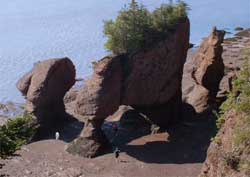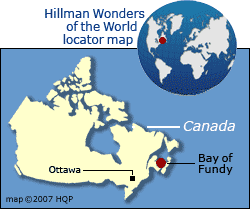Bay of Fundy
 Why the
Bay of Fundy
is special
Why the
Bay of Fundy
is specialThe differences between the low and high tides in the upper part of the Bay of Fundy in Canada can be as high as 17 meters or 56 feet. The year-round average is 11 meters or 36 feet.
Bay of Fundy tips & insights
Size and geography
The Bay of Fundy is 430 kilometers (270 miles) long and lies between the Canadian provinces of New Brunswick and Nova Scotia.
Tides
The Bay of Fundy is tied with Ungawa Bay (farther north in Canada) for having the world's most extreme tides.
A full tidal cycle occurs twice a day, lasting approximately 12 hours. I recommend you spend at least one night in the Bay of Fundy area so you can observe the complete rise-and-fall phenomenon.
Reversing Falls
Also see the Reversing Falls near the city of Saint Johns in New Brunswick. The tidal water that rushes over rocks changes directions every six hours.
Hopewell Rocks
This destination is popular. Its tall, bizzarre red rock formations were sculpted over the eons by the rushing tidal waters. When the tide is in, you can walk on the ocean floor (see photo above). Six hours later, the beach and lower half of the vegetation-crowned rocks are underwater. You have to time your visit based on the tides.
Tidal bores
They are surf-like waves that rush up a river, then down it. Raft surfing on them is a local sport. Unfortunately, some tidal bore sites are now only wimpy versions of their former selves due to downriver construction projects.
What causes the tides
Several natural forces create the Bay of Fundy tides.
- Gravitation
From the sun and moon.
- Bay's funnel shape
As the bay's width and depth decreases, the tide's momentum and therefore its height increases
- Other factors
The water level will be higher when its full or new moon - or when the moon is closest to the earth during its orbit - or when an ocean storm creates a surge.



